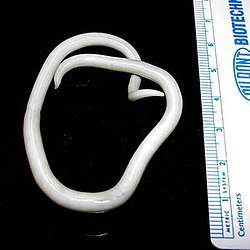Ascaris lumbricoides
| Ascaris lumbricoides | |
|---|---|
 |
|
| An adult female Ascaris worm | |
| Scientific classification | |
| Kingdom: | Animalia |
| Phylum: | Nematoda |
| Class: | Secernentea |
| Order: | Ascaridida |
| Family: | Ascarididae |
| Genus: | Ascaris |
| Species: | A. lumbricoides |
| Binomial name | |
|
Ascaris lumbricoides Linnaeus, 1758 |
|
Ascaris lumbricoides is the "giant roundworm" of humans, growing to a length of up to 35 cm (14 in). It is one of several species of Ascaris. An ascarid nematode of the phylum Nematoda, it is the most common parasitic worm in humans. This organism is responsible for the disease ascariasis, a type of helminthiasis and one of the group of neglected tropical diseases. An estimated one-sixth of the human population is infected by A. lumbricoides or another roundworm. Ascariasis is prevalent worldwide, especially in tropical and subtropical countries.
Ascaris lumbricoides, a roundworm, infects humans when an ingested fertilised egg becomes a larval worm (called rhabditiform larva) that penetrates the wall of the duodenum and enters the blood stream. From there, it is carried to the liver and heart, and enters pulmonary circulation to break free in the alveoli, where it grows and molts. In three weeks, the larva passes from the respiratory system to be coughed up, swallowed, and thus returned to the small intestine, where it matures to an adult male or female worm. Fertilization can now occur and the female produces as many as 200,000 eggs per day for a year. These fertilized eggs become infectious after two weeks in soil; they can persist in soil for 10 years or more.
...
Wikipedia
